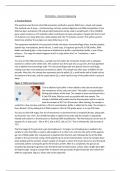Exam (elaborations)
TMN3702 Assignment 3 (ANSWERS) 2024 - DISTINCTION GUARANTEED
- Institution
- University Of South Africa (Unisa)
- Book
- Teaching English
Well-structured TMN3702 Assignment 3 (ANSWERS) 2024 - DISTINCTION GUARANTEED. (DETAILED ANSWERS - DISTINCTION GUARANTEED!).... QUESTION 1 1.1 What aspects should a home language teacher keep in mind when teaching a home language to intermediate phase (IP) learners in a multicultural context? (20) ...
[Show more]












